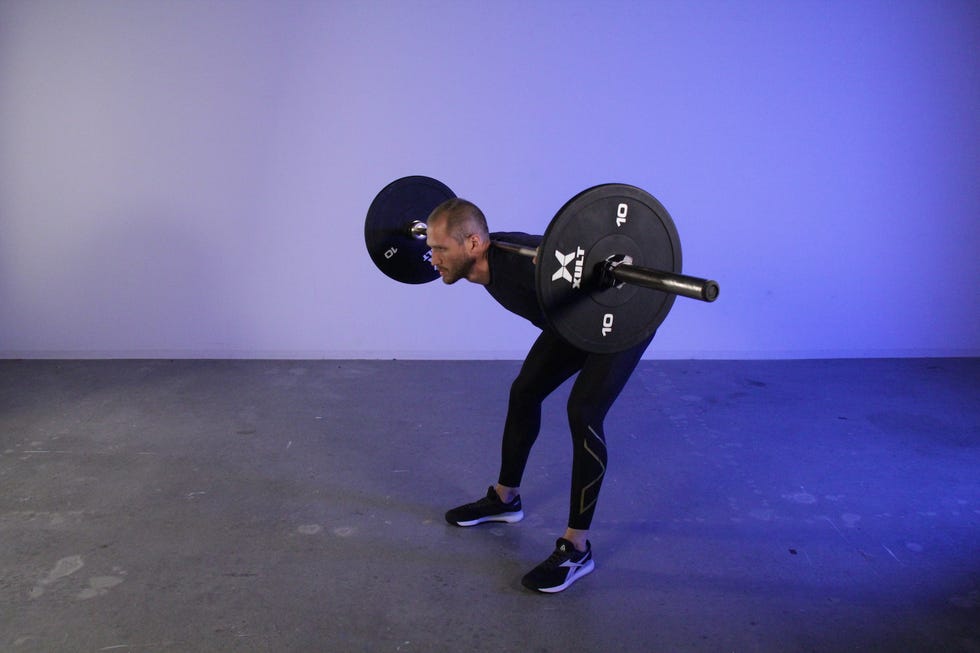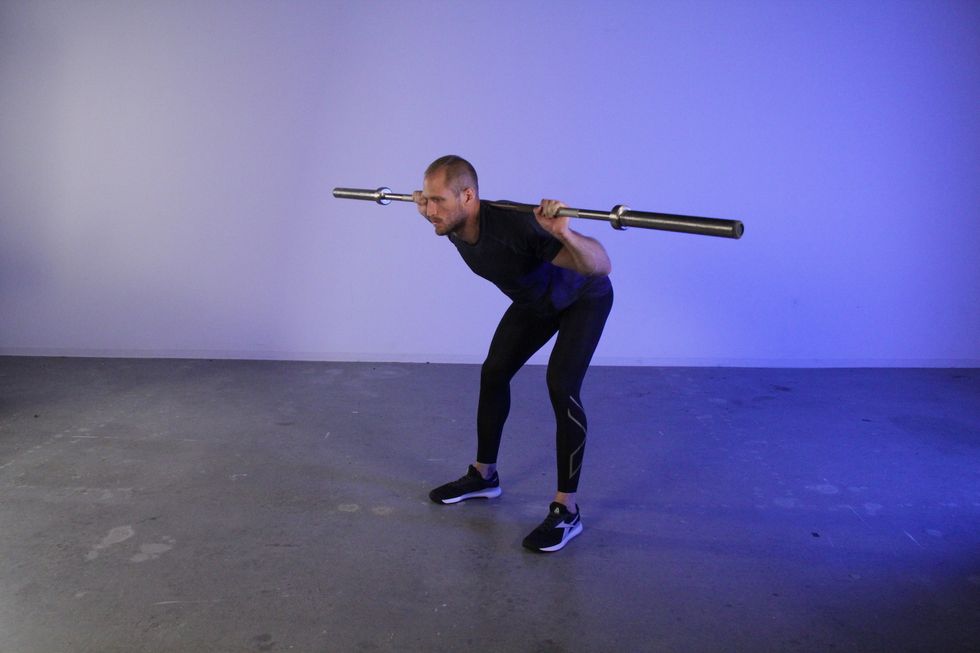A KEY TO building up your biggest, most important lower body muscles is the hip hinge, and one of the best ways to hone that essential movement is to master the good morning.
No, it’s not the greeting you should give to your gym buddies when you hit the weight room floor for an early workout—it’s a barbell maneuver that can be surprisingly technical. The exercise might not be one of the most common leg day staples, but it gives you another option to hammer those posterior lower body muscles.
Especially given the placement of the load, you shouldn’t settle for anything other than perfect form when you add the good morning to your training plan. Your positioning and posture are essential to recruiting the right muscles and keeping your lower back safe and healthy. Here, Men’s Health fitness director Ebenezer Samuel, C.S.C.S. and senior fitness editor Brett Williams, NASM guide you through the cues and details you’ll need to master the good morning.

How to Do the Good Morning
- Start by loading a barbell on a rack, like you would do for a barbell back squat. Dip under the bar, pull yourself up into it squeezing your mid-back muscles, and step away from the rack with the barbell on your shoulders. Especially for this exercise, keep the bar off your neck.
- Grip the bar tightly with your hands. Screw your elbows forward into an externally rotated position, in line with your torso.
- Squeeze your shoulder blades, core, and glutes to create full-body tension.
- Push your butt back, then bend at the waist to lower your torso to the floor. Keep your shins vertical and arch your back slightly to avoid any rounding. Keep your gaze at the floor to keep your spine in a neutral position.
- Continue pushing your butt back, lowering slowly until you feel tension in your hamstrings. If your back begins to round, you’ve gone too far.
- Stand back up slowly, controlling the weight. As you stand up, squeeze your glutes to come into hip extension.
Take note of these additional cues from Samuel to shore up your good morning form:
Weight On Your Back, Not Your Neck
Eb says: Make sure the barbell sits on your upper back, not on your neck. If you have it on your neck, you’re creating a longer lever with your torso, and instantly putting great strain on your lower back, even if your form is clean. You’re also placing a lot of direct pressure on your neck.
The best spot for the weight is on your upper back with your hands aggressively gripping the bar so it can’t slip. Do your best to keep it there to get the most out of the move.
Butt Goes Back
Eb says: Focus not on bending at the waist when you do good mornings, but on pushing your butt back. By doing this, you’ll create a friendlier and safer angle for your lower back, and you’ll also get proper stretch on your hamstrings.
This is a more natural way to move, and it’ll help prevent you from rounding at the lower back.

NEVER. ROUND.
Eb says: The beauty of the good morning, and what makes it different than a Romanian deadlift or other deadlift variations, is how it forces you to brace every part of your torso. You can sometimes cheat on a deadlift or Romanian, loosening up through your shoulder blades or through your lower back (never a good thing).
You can’t do that on the good morning and must focus that much more on technique. Really squeeze those shoulder blades and brace your entire core on every good morning rep. That’ll prevent you from rounding either at the lower back or the upper back.
Stay In Your Range
Eb says: Don’t worry if you can’t get your torso horizontal to the ground. Work within your own mobility. That may mean hinging over to a 45-degree angle, or even less, depending on your hip mobility and your hamstring flexibility. That’s OK.
The more you do the good morning, the more range you’ll gain over time. That progress may be slow, but you’ll still get value from the move if you take your time on every rep.
What Muscles the Good Morning Works
The good morning will work your hip hinge, a key movement pattern. That means you’ll be hammering the big posterior leg muscles, the hamstrings and glutes. Like its cousin the Romanian deadlift, you can emphasize the eccentric portion of the good morning to make that hamstring work even more pronounced.
The placement of the weight means that you’ll also be tasked to brace your core muscles to maintain postural integrity. The good morning is also a sneaky move to challenge your abs because of this.
Benefits of the Good Morning
The good morning gives you another exercise to work your hip hinge, building your hamstrings and glutes. This can be helpful if you’re looking to build muscle, strength, and power, since those muscles are essential for movement.
Common Good Morning Mistakes to Avoid
The good morning is a valuable leg day move, but you do need to be very mindful of a few things when you use it in your workouts to avoid lower back injuries.
First, make sure that the bar stays on your shoulders. If you allow it to shift forward to your neck, you’ll be in a potentially compromised position for your spine and lower back. Second, Samuel emphasizes that weight should be a secondary factor for this move. Don’t load the bar too heavy, especially to start. Thirdly, you should never rush through your good morning reps. Samuel advises a three count on the eccentric portion of the movement. Lastly, you should never allow your back to round. This should be a sign that you’ve gone past your safe range of motion. Allow your back to arch instead.
How to Add the Good Morning to Your Workout Plan
Samuel cautions that you have to be smart with the good morning, since it can be such a technical movement given the placement of the load. Use the move once a week within your split at most, with 3 sets of 5 to 8 reps using slow, deliberate tempo.
Want to master even more moves? Check out our entire Form Check series.
